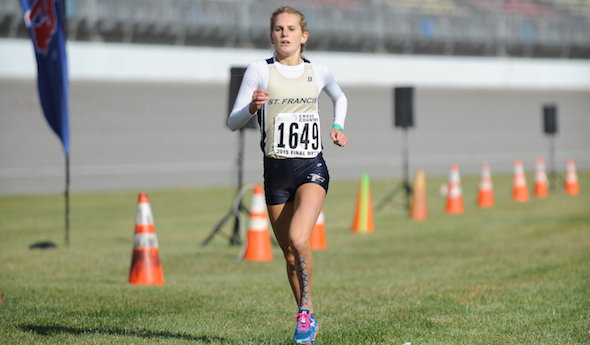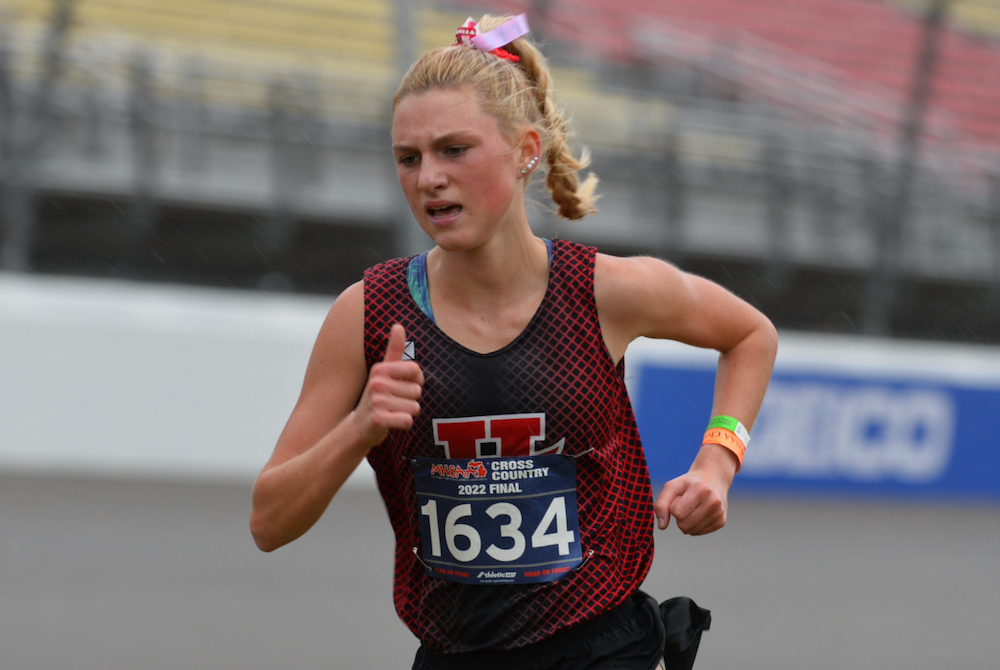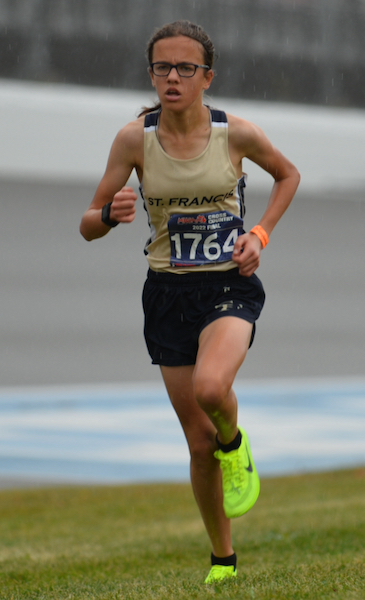
St. Francis Follows Bullough to D3 Title
November 7, 2015
By Bill Khan
Special for Second Half
BROOKLYN — Holly Bullough knows something about playing with pain.
She is, after all, from one of Michigan's most well-known football families.
 So, she wasn't going to let a stress fracture in her left foot keep her from defending her MHSAA Lower Peninsula Division 3 championship on Saturday at Michigan International Speedway.
So, she wasn't going to let a stress fracture in her left foot keep her from defending her MHSAA Lower Peninsula Division 3 championship on Saturday at Michigan International Speedway.
Bullough wasn't able to run in practice the last two weeks, keeping in shape by hitting the spinning bike hard at a yoga center in Traverse City. It worked, as she was fit enough to dominate the Division 3 field, winning by 36.4 seconds with a time of 17:41.8.
Bullough shattered her own LP Division 3 record of 17:51.3, set last year when she surged ahead at the finish to edge Amber Way of Charlevoix by 0.2 seconds.
"I was pretty tired," Bullough said. "I just needed to finish and try to finish as strong as I can."
She said she felt some of the effects of running only once in the previous two weeks, that being in the regional meet a week earlier when she won in 17:15.40. It was a week before regionals that she noticed something didn't feel right.
"After this one meet, I was limping after it," she said. "I was like, "I need to get an X-ray.'"
The X-ray revealed a stress fracture in the second metatarsal bone in her left foot.
She has numerous examples in her own family of athletes who know a thing or two about toughing it out. Her grandfather, father and three brothers played football at Michigan State, with Riley and Byron on the current roster. Hank Bullough, her grandfather, was a starting guard on MSU's 1954 Rose Bowl championship team. Her father, Shane, was a linebacker at MSU. Brother Max is on the Houston Texans' roster.
An injury was going to be the only thing to keep Bullough from repeating as Division 3 champion. Nobody went out with her, as she built a 28-second lead by the two-mile mark.
 "I was more worried coming into regionals, because that's when I had the longest break, but I was still nervous," Bullough said.
"I was more worried coming into regionals, because that's when I had the longest break, but I was still nervous," Bullough said.
Winning the individual title was more special for Bullough this time around, because she was able to lead her team to a championship, as well.
St. Francis scored 69 points to easily beat Benzie Central by 72. Shepherd was third with 181 points.
The Gladiators didn't even qualify for the Final last year, finishing sixth in their Regional to miss out on a trip to MIS for only the second time in 14 years. Bullough is the only runner from that regional lineup that ran in the Final on Saturday.
"It's awesome. I love it. It's so much better than being alone," Bullough said.
Also scoring for the Gladiators were freshman Katelyn Duffing (fourth, 18:35.2), junior Emmalyne Tarsa (fifth, 18:42.3), sophomore Joyana Tarsa (12th, 19:05.1) and sophomore Lauren Bramer (66th, 20:23.5).
The title was the second for St. Francis, which was the LP Division 4 champion in 2003.
The MHSAA Cross Country Finals are sponsored by the Michigan National Guard.
PHOTOS: (Top) Alone on the final stretch, Traverse City St. Francis’ Holly Bullough surges toward the finish line. (Middle) Bullough and teammate Katelyn Duffing (1650) lead the St. Francis pack, including Emmalyne Tarsa (1653), off the start. (Click for more from RunMichigan.com.)

Jazwinski Brings Hart Individual Title as St. Francis Moves to Front of Team Pack
November 5, 2022
BROOKLYN – Cross country races can be won between the ears before runners ever step foot onto the course.
Attitudes were tested as rain began to descend on Michigan International Speedway and the wind picked up just before the start of the MHSAA Lower Peninsula Division 3 girls race late Saturday morning.
Hart sophomore Jessica Jazwinski was loving life as she prepared to race.
“As a distance runner, I really try to love the wind,” she said. “Distance running and cross country is just a tough sport. The wind just adds to it — and the rain, too. It’s super fun.
“I was just thinking these conditions are just gonna feed my great race. This is real cross country. Yeah!”
Jazwinski overcame the elements to run the fifth-fastest Division 3 time ever, winning with a time of 17:36.70. She has two of the top-five times in Division 3 Finals history, having run 17:31.4 to place third last year.
“Today my race plan was just to go out hard and try to hold on to my pace,” she said. “I feel like I tried to race a lot like Steve Prefontaine, just go out and hold on.”
 Lansing Catholic senior Hannah Pricco was second in 18:17.59, Onsted sophomore Emmry Ross was third in 18:20.96 and Hart junior Alyson Ens was fourth in 18:28.52.
Lansing Catholic senior Hannah Pricco was second in 18:17.59, Onsted sophomore Emmry Ross was third in 18:20.96 and Hart junior Alyson Ens was fourth in 18:28.52.
“I love having great teammates to work with and encourage each other,” Jazwinski said. “We really try to encourage each other so much throughout the races. Throughout this year, some races she’s been a minute behind me, some races she’s been five seconds. I don’t want her to ever beat me, so that pushes me so much. I know she’s trying to race me and get up there with me.”
The only downer for Hart was having its string of Division 3 championships end at five with a fourth-place finish. Hart had two runners in the top four, but its No. 3 runner was 68th.
“I would totally trade my individual title for a team title,” Jazwinski said.
Traverse City St. Francis emerged from a close battle to win its first title since 2016 with 134 points. Pewamo-Westphalia was second with 142 and Lansing Catholic third with 165.
Sophomore Betsy Skendzel led St. Francis, placing seventh in 18:48.33. Completing the team score were senior Sophia Rhein in 26th (19:43.27), sophomore Grace Slocum in 33rd (20:07.95), junior Rylee Duffing in 60th (20:44.82) and junior Margot Hagerty in 63rd (20:45.78).
Lansing Catholic had three place in the top 10, but didn’t get another finisher until 103rd.
PHOTOS (Top) Hart’s Jessica Jazwinski pushes toward the finish during Saturday’s LPD3 Final. (Middle) Traverse City St. Francis’ Betsy Skendzel leads the way for the eventual team champion. (Click for more from Dave McCauley/RunMichigan.com.)

